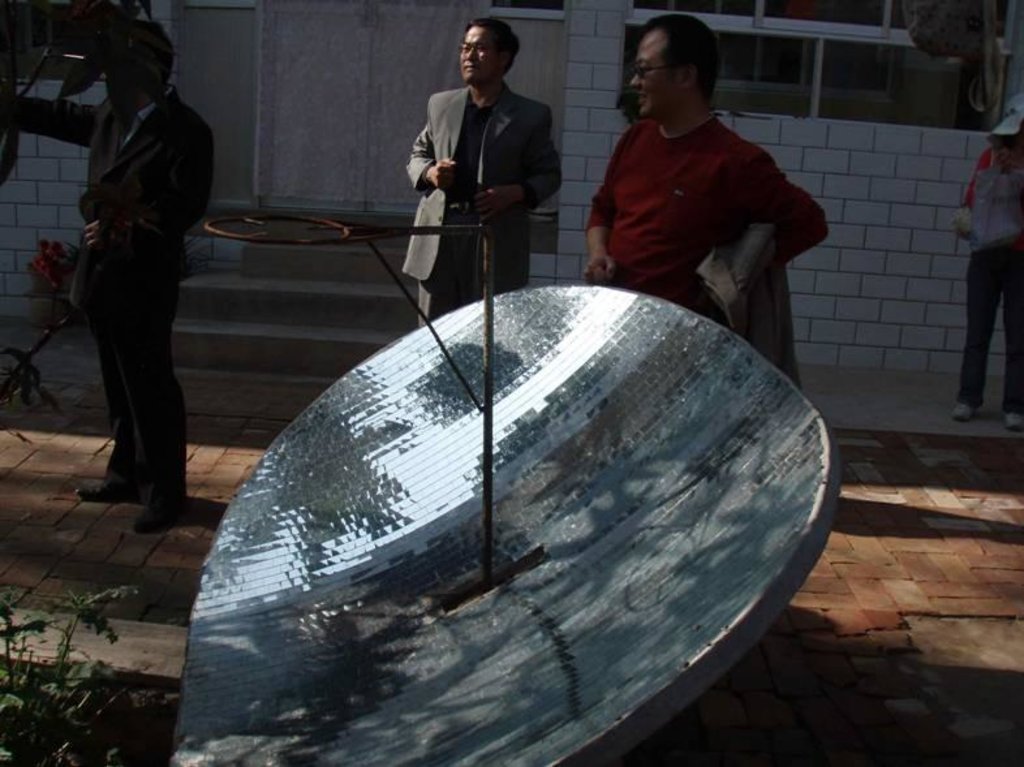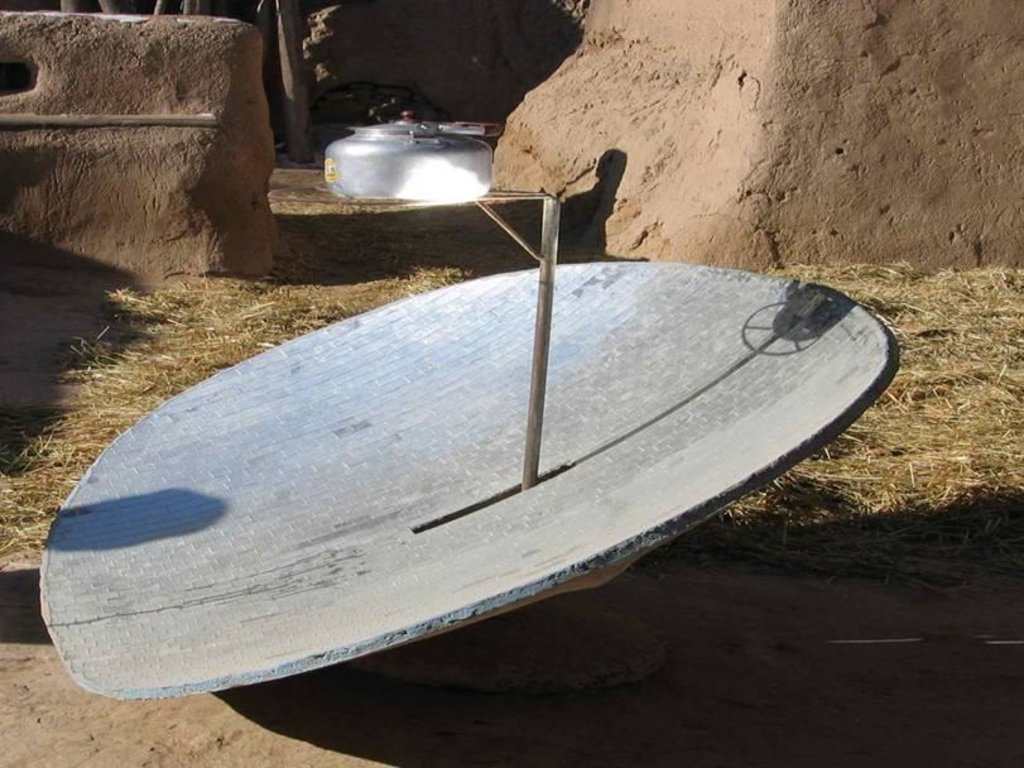Solar Stove for Rural Communities [中国]
- 创建:
- 更新:
- 编制者: Anna Schuler
- 编辑者: –
- 审查者: Laura Ebneter
approaches_2433 - 中国
查看章节
全部展开 全部收起1. 一般信息
1.2 参与方法评估和文件编制的资源人员和机构的联系方式
SLM专业人员:
Zhang Peng
0971-6365120
zhp1218001@163.com
Qinghai Provincial Forestry Bureau
No.25, Xichuannanlu Road, Xining, Qinghai, postcode 810008
中国
有助于对方法进行记录/评估的机构名称(如相关)
Qinghai Provincial Forestry Bureau - 中国有助于对方法进行记录/评估的机构名称(如相关)
CDE Centre for Development and Environment (CDE Centre for Development and Environment) - 瑞士1.3 关于使用通过WOCAT记录的数据的条件
编制者和关键资源人员接受有关使用通过WOCAT记录数据的条件。:
是
2. SLM方法的描述
2.1 该方法的简要说明
Solar stoves use solar energy for cooking, featuring environmental-friendly, zero pollution, low cost, easy operation and maintenance, safe and convenient use, saving firewood, etc. To operate the stove, adjust condenser aiming at the sun with the spot on stove or other objects to be heated.
2.2 该方法的详细说明
该方法的详细说明:
Qinghai has high elevation, with intense and long sunshine to suit dissemination of the technology to compensate for the shortage of fuel in the countryside, effectively reducing the labor in wood/grass cutting and vegetation destruction, protecting the environment and promoting soil degradation control. Therefore the technology has significant ecological and social benefits.
Restrictions in use: it can only be operated when sunlight is available; operation requires manual adjustment of aim from time to time (lack of sunlight auto-tracking technology application) resulting in an operative time efficiency of about 40%. Solar stove dissemination is financed by the government with labor input by farmers and herdsmen. International financial aid is utilized as an effective incentive for implementation. Publicity and demonstration were conducted to attract more families to use solar stoves. Farmers are the users and beneficiaries so that training to them on operation and maintenance should be conducted.
In 2005, the solar stove dissemination started and so far 150 units have been in operation representing 28% of total demonstration households. Satisfactory results have been achieved. At present, Qinghai provincial government provides special financial support to the dissemination of solar stove extension so the technology application has a bright prospect.
2.3 该方法的照片
2.5 采用该方法的国家/地区/地点
国家:
中国
区域/州/省:
Qinghai Province
有关地点的进一步说明:
Shazhuyu pilot of Gonghe County
2.6 该方法的开始和终止日期
注明开始年份:
2005
2.8 该方法的主要目的/目标
Aims of the approach are to: - form the technology dissemination mechanism that integrates related organizations; - carry out environmental awareness education and raise community participation level; - develop technical training to raise the community's capability in ecological protection; - use alternative energy to solve the rural fuel insufficiency problem and to alleviate the pressure on the environment; - Protect and increase vegetation cover and improve ecological conditions
The SLM Approach addressed the following problems: - lack of fuel and firewood cutting damage vegetations in the rural area; - serious soil and water erosion ; - topsoil losses; - decline of soil fertility.
2.9 推动或妨碍实施本办法所适用的技术的条件
财务资源和服务的可用性/可得性
- 阻碍
Farmer households are poor and short of funds
Treatment through the SLM Approach: Government provides financial support with counterpart funds from households. Access to international assistance.
了解SLM,获得技术支持
- 阻碍
The technology is not mature. Most solar stoves are artificially operated unable of tracking automatically the sun. Weather condition may also affect the use efficiency.
Treatment through the SLM Approach: Research and developemnt to resolve the technical problems and reduce the cost.
3. 相关利益相关者的参与和角色
3.1 该方法涉及的利益相关者及其职责
- 当地土地使用者/当地社区
- 国家政府(规划者、决策者)
3.2 当地土地使用者/当地社区参与该方法的不同阶段
| 当地土地使用者/当地社区的参与 | 指定参与人员并描述活动 | |
|---|---|---|
| 启动/动机 | 外部支持 | Accept education of solar energy technology |
| 计划 | 互动 | The participatory planning on solar stove extension |
| 实施 | 外部支持 | Use and disseminate solar stoves |
| 监测/评估 | 互动 | Monitoring and evaluation of the solar stove application |
| Research | 无 |
3.4 有关SLM技术选择的决策
解释:
experts of rural new energy use/ecological protection experts /project implementation organizer/ government poverty reduction office
4. 技术支持、能力建设和知识管理
4.1 能力建设/培训
是否为土地使用者/其他利益相关者提供培训?:
是
明确受训人员:
- 土地使用者
培训形式:
- 示范区域
涵盖的主题:
The training includes solar stove installation, operation and maintenance is conducted in form of site demonstration; The effect of training to households especially the training to woman is acceptable.
4.3 机构强化(组织发展)
是否通过这种方法建立或加强了机构?:
- 是,适度
具体说明机构的强化或建立程度:
- 本地
具体说明支持类型:
- 财务
提供进一步细节:
Application of the technology changes the villager's energy consumption manner, with decreased expenditure and increased income. Therefore it is helpful for poverty reduction and environmental protection. The extension also promoted the capacity building of local forestry organizations.
4.4 监测和评估
监测和评估是该方法的一部分吗?:
是
注释:
bio-physical aspects were monitored through measurements; indicators: Site measure the light application time and illumination intensity
technical aspects were monitored through measurements; indicators: Hours of soalr stove use (the use rate). Estimate the quantity of firewood saving.
socio-cultural aspects were monitored through measurements; indicators: Survey the villagers acceptance to the technology and comments from women
economic / production aspects were monitored through measurements; indicators: Calculate the economic value equivalent to standard coal.
area treated aspects were monitored through measurements; indicators: Survey the number of household users
management of Approach aspects were monitored through measurements; indicators: Survey regularly the household users, monitor and evaluate their feedback information
There were changes in the Approach as a result of monitoring and evaluation: Adopt the participatory type and not the administrative type of extension approach.
4.5 研究
研究是该方法的一部分吗?
是
明确话题:
- 技术
提供进一步的细节,并指出是谁做的研究:
Undertaken by the solar research institutions and on the topics of solar stove automatic tracking, energy storage, new building materials, raising utilization efficiency etc.
5. 融资和外部物质支持
5.1 该方法中SLM组成部分的年度预算
注释(例如主要的资助来源/主要捐助者):
Approach costs were met by the following donors: government: 90.0%; local community / land user(s): 10.0%
5.2 为土地使用者提供财政/物质支援
土地使用者是否获得实施该技术的财政/物质支持?:
是
5.3 对特定投入的补贴(包括劳动力)
- 设备
| 具体说明哪些投入得到了补贴 | 程度如何 | 对补贴做出具体说明 |
|---|---|---|
| solar stove | 充分融资 | covered by government |
注释:
labor of transportation of solar stove is solved by farmer households.
5.4 信用
是否根据SLM活动的方法给予信用值?:
否
6. 影响分析和结论性陈述
6.1 方法的影响
该方法是否帮助土地使用者实施和维护SLM技术?:
- 否
- 是,很少
- 是,中等
- 是,支持力度很大
Investigate the conditions of vegetation cover increase, soil and water erosion reduction in the technology application areas.
Did other land users / projects adopt the Approach?
- 否
- 是,很少
- 是,中等
- 是,支持力度很大
The technology has also been adopted in other areas and other projects.
6.4 该方法的长处/优点
| 编制者或其他关键资源人员认为的长处/优势/机会 |
|---|
| The top-down extension is effective (How to sustain/ enhance this strength: raise the capacity of the governmental organization ) |
| farmers further spread the technology among themselves by observation and visits (How to sustain/ enhance this strength: enhance the training and extension) |
| farmers benefit through reduced expenditure in energy (How to sustain/ enhance this strength: use meanwhile other clean energy forms) |
6.5 该方法的弱点/缺点以及克服它们的方法
| 编制者或其他关键资源人员认为的弱点/缺点/风险 | 如何克服它们? |
|---|---|
| backward economy affect the extension speed | strengthen project support |
| sole financing channel for the technology | form co-financing arrangement of government, individuals and international donors |
7. 参考和链接
7.1 方法/信息来源
- 实地考察、实地调查
- 与土地使用者的访谈
链接和模块
全部展开 全部收起链接
无链接
模块
无模块




